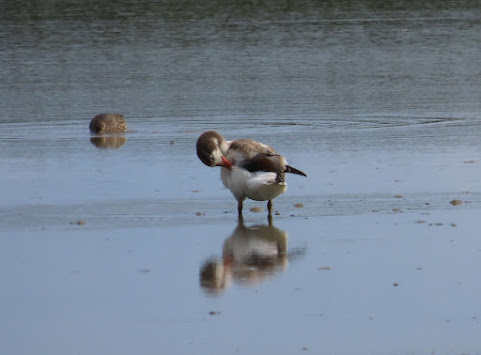This was my first visit to North Norfolk in nearly a year, a welcome return to one of the best birdwatching areas in the country, a chance to see the two reserves of Cley and Titchwell. Both these sites are great for birds, and are very evenly matched when compared side to side but if I was forced to pick a favouirte, I would have to go with Cley.
A series of scrapes within wet grassland and reedbeds, Cley is a haven for migrant birds, which descend on the Norfolk coast at this time of year. WADERS are the main focus, as late August is the time when Autumn migration reaches a peak for them, although things seem a little late this year, or maybe its just a poor year. I'm still holding out for greater things to come.
The main focal point of the reserve are the two freshwater scrapes, Pat's Pool and Simmond's Scrape, overlooked by a series of hides, although one hide was closed as SWALLOWS were nesting inside. These scrapes are looking quite good with lots of mud providing food for the waders to feed on as they pass through. Pat's Pool, the largest scrape was crammed full of birds. A CURLEW SANDPIPER was present looking like a similar DUNLIN, although the CW is more elegant, has a more curved bill, longer legs, and a more elegant shape. Also present were two SPOTTED REDSHANK, an adult and juvenile, a KNOT, a GREEN SANDPIPER, and 24 RUFF.
From one of the scape hides, what must be one of the strangest sights of the day was observed. A BITTERN was seen flying high over the reserve, just about seen as a speck in the sky. Was this a migrant having arrived on these shores from abroad or a wandering local? Whatever, it was my first record for Cley, my first flying so high, and an unusual record for August.
On the nearby Simmond's Scrape things were a bit more quiet, with proceedings dominated by a SPOONBILL, standing astride the shallow water but mainly staying asleep, with its head tucked in. A LITTLE STINT present here was also good, the smallest of the scarcer common waders. Also around were a GREEN SAND and a SNIPE. Several BEARDED TITS were seen here, coming out from the reeds to feed on the exposed mud before. On the Scrapes there were plenty of TEAL, with smaller numbers of other commoner ducks, typically asleep, with their heads tucked in. Ducks can at times be low energy.
Upon walking out of the hides and along the boardwalk, a BROWN HARE graced me with its presence, bursting forth from the reeds, running along the path before disappearing again.
The reserve footpath is basically a square shape. One side is the East Bank, a footpath with reedbeds on the west side, and grazing marsh on the other, eventually leading up to the sea. Within the grazing marsh there were a good assortment of pools and scrapes, gradually becoming more saline as they got closer to the sea. Arnold's Marsh is the final pool, nestled just behind the dunestack. A large pool, its a good spot for esturarine WADERS, such as DUNLIN, CURLEW, REDSHANK and TURNSTONE. Also present were a decent number of roosting SANDWICH TERNS on the various islands, this is a good site for this bird.
Another of the side of the square of paths is the sea, walking along the dunes with the reserve to the south. Things were a bit quieter round here, with only a few GANNETS flying lazily offshore. Small flocks of WADERS were flying up and down the coast, with some SANDERLING being the most interesting.
From Cley Marshes I had a walk to Blakeney as I was staying at a hotel there. The route from Cley traversed the river bank along Blakekney Fresh Marsh, an area of rough grassland, grazed by cattle and sheep. Its not a nature reserve, but is fairly overgrown, with lots of reeds growing amongst the grazed areas. It was pretty quiet with the usual birds of open grassland. A typically brief STOAT was good as well as a TOAD sitting on the footpath, waiting to be trod on.
In the end it was a fairly standard August day on the North Norfolk coast, seeing pretty much what I expected to see, with a few strange sightings adding to the mix. North Norfolk is one of the best areas for birdwatching in the country, so a visit up there is always worthwhile, even if nothing much is around. I cannot complain though, especially as I get to spend my time doing a hobby I love, in places that I'm also so fond of. It can be a hard life at times.










No comments:
Post a Comment